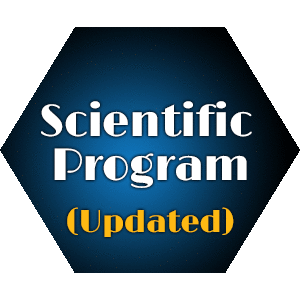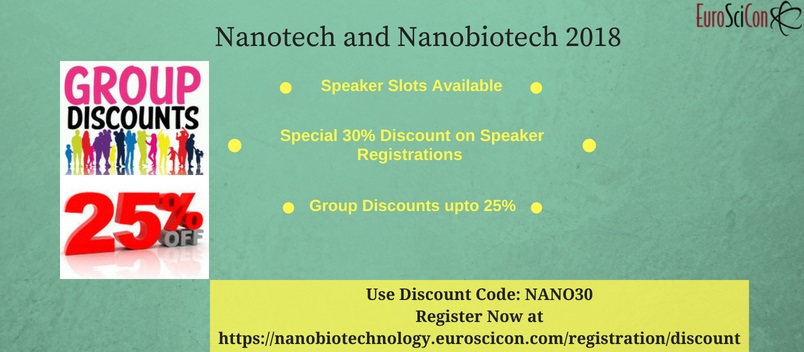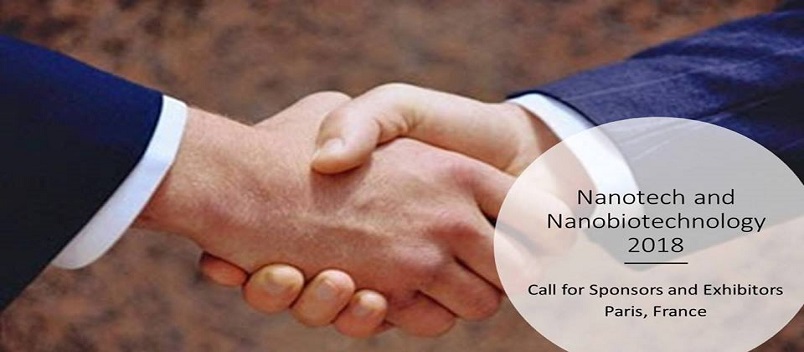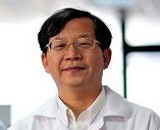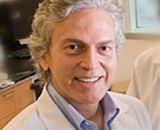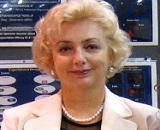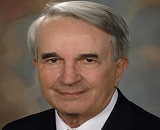Nanotech & Nanobiotechnology 2018
About Conference
The EuroSciCon will be holding conference on Nanotech & Nanobiotechnology 2018 which is scheduled during July 12-13, 2018 at Paris, France. The theme of the conference is “Challenges and Innovations in next generation Nanoscience".
The Nanobiotech 2018 aims to bring together leading academic scientists, researchers and research scholars to exchange and share their experiences and research results about all aspects of Nanomedicine in Healthcare. It also provides the premier interdisciplinary forum for researchers, practitioners and educators to present and discuss the most recent innovations, trends, and concerns, practical challenges encountered, and the solutions adopted in the field of Nanomedicine. The conference program will cover a wide variety of topics relevant to the Nanomedicine, including: Nanomedicine in drug discover and delivery, Nano diagnostics, theragnostic, applications of Nanomedicine in healthcare applications and disease treatments.
What's New
Nanotech & Nanobiotechnology 2018 includes international attendee workshops, lectures and symposia, including a designated registration area, a refreshment break and gala lunch. Nanotechnology educators can join the EuroSciCon as an international member to receive discounts on registration. So, come and join leading experts and allied professionals from July 12-13, 2018 in Paris, France to keep up with the rapidly accelerating pace of change that is already having an impact on the field of Nanotechnology, Nanomedicine & Nanobiotechnology and will continue to in the future. The field of Nanotechnology have not only helped the development in different fields in science and technology but also contributed towards the improvement of the quality of human life to a great extent. All this has become possible with the different discoveries and inventions leading to the development of various applications. The core aim of Nanotech & Nanobiotechnology 2018 conference is to provide an opportunity for the delegates to meet, interact and exchange new ideas in the various areas of Nanotechnology and Biotechnology.
About Paris, France
Paris is the capital and most populous city of France. The city is both a commune and department and forms the Centre and headquarters of the France, or Paris Region. By the 17th century, Paris was one of Europe's major centers of finance, commerce, fashion, science, and the arts, and it retains that position still today. The Paris Region had a GDP of €624 billion (US $687 billion) in 2012, accounting for 30.0 percent of the GDP of France. Paris is often referred to as "The City of Light" (La Ville Lumière), both because of its leading role during the Age of Enlightenment , and more literally because Paris was one of the first European cities to adopt gas street lighting. In the 1860s, the boulevards and streets of Paris were illuminated by 56,000 gas lamps. Since the late 19th century, Paris has also been known as Pan-am.
Paris has many important cultural institutions: its Louvre museum is the most visited in the world; its Musée d'Orsay is noted for its collection of French Impressionist art, and its Pompidou-center Musée National d'Art Moderne has the largest collection of modern and contemporary art in Europe. The central area of the city along the Seine River is classified as a UNESCO Heritage Site and includes many notable monuments, including Notre Dame Cathedral, the Sainte-Chapelle, the former Universal Exposition Grand Palais, Petit Palais and Eiffel Tower, and the Basilica of Sacré-Cœur in Montmartre. In 2015, Paris received 22.2 million visitors, making it one of the world's top tourist destinations.
Sessions & Tracks
The term Nanobiotechnology refers to the combination of nanotechnology and biology. The concepts that are enhanced through Nano biology include: Nanoparticle, Nano device and Nano scale phenomena that occurs within the discipline of nanotechnology. This approach to biology allows scientists to imagine and create systems that can be used for biological research.
- Gene Therapy
- Bioluminescent magnetic nanoparticles
- Surface modified polystyrene nanoparticle
- Target specific drug delivery
- Disease diagnosis
- Lipid Nanotechnology
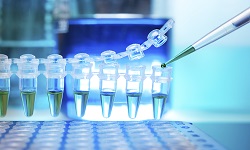
ToxicologyNanomedicine is a field of medical science whose applications are increasing more and more thanks to nanorobots and biological machines, which constitute a very useful tool to develop this area of knowledge. In the past years, researchers have done many improvements in the different devices and systems required to develop nanorobots. This supposes a new way of treating and dealing with diseases such as cancer; thanks to nanorobots, side effects of chemotherapy have been controlled, reduced and even eliminated, so some years from now, cancer patients will be offered an alternative to treat this disease instead of chemotherapy, which causes secondary effects such as hair loss, fatigue or nausea killing not only cancerous cells but also the healthy ones.
- Pharmaceuticals
- Nano surgery
- Nano biosensor
- Nanodrug delivery method
- Nanomedical devices
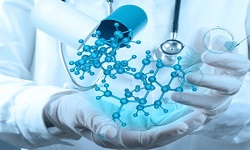
Nanopharmaceuticals are colloidal elements of 10 to 1,000 nanometers in size. They are commonly used in drug delivery. Nanopharmaceuticals are varied both in their shape and composition and frequently offer an improvement as compared to their “bulk” complements primarily because of size. Numerous pharmaceutical companies are using nanotech to reconsider shelved drugs that were “difficult” from a design point of-view due to their solubility profiles.
- Nanoparticles
- Nanoemulsions
- Nanocapsules
- Biodegradability, Transformation, Alteration
- Bioaccumulation
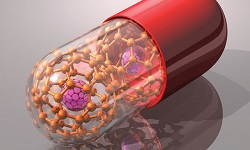
Nanoelectronics are based on the application of nanotechnology in the field of electronics and electronic components. Although the term Nanoelectronics may generally mean all the electronic components, special attention is given in the case of transistors. These transistors have a size lesser than 100 nanometers. Visibly, they are very small that separate studies must be made for knowing the quantum mechanical properties and inter-atomic design. As a result, though the transistors appear in the nanometer range, they are designed through nanotechnology. Their design is also very much different from the traditional transistors and usually falls in the category of one dimensional nanotubes/nanowires, hybrid molecular electronics, or advanced molecular electronics. This technology is said to be the next future, but its practicality is near to impossible even now that they may be difficult to emerge soon.
- Nano microscopy
- Nano micro machinery
- Carbon nanotube actuators
- Nanomotor
- Nano transistors and Nanowires
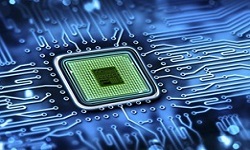
Nanodevices, the quickest moving segment of the general market, the Nanotech research involves in smart sensors and smart delivery systems, Magnetic Nanodevices, Nano-biosensors, Nano switches, Optical biosensors, and biologically inspired gadgets are predicted to transport at a excellent 34% CAGR. Nano-biosensors for 78.8 % of the phase Nanoswitches & Optical biosensors are anticipated to develop to $52.7 billion via 2019 and register a healthy 20.7% CAGR. Nanosensors will better hit upon the onset of sicknesses along with cancer or coronary heart ailment, and Nanomarkets expects the marketplace for biomedical nanosensors to attain approximately $800 million in 2019. around 18 universities and 53 new research initiatives are exhibited in Nanotechnology convention.
- Biologically inspired devices
- Quantum dots/Nanodots
- Smart sensors and smart delivery systems
- Magnetic nanodevices
- Nano-biosensors
- Nanoswitches
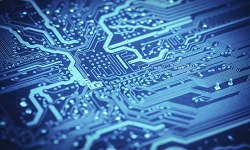
A nanorobotics is a machine that can build and manipulate things precisely at an atomic level. Imaging a robot that can pluck, pick and place atoms like a kid plays with LEGO bricks, able to build anything from basic atomic building blocks. While some people dismiss the future of nanorobots as science fiction, you should realize that each of us is alive today because of countless nanobots operating within each of our trillions of cells. We give them biological names like a “ribosome,” but they are essentially machines programmed with a function like “read messenger RNA to create a specific protein.”
- Robotic logging technology
- Nanobiochips
- Nano 3D printing
- Nanometer

Nano chemistry, described the field as "an emerging subdiscipline of solid-state chemistry that emphasizes the synthesis rather than the engineering aspects of preparing little pieces of matter with nanometer sizes in one, two or three dimensions. … The Nano chemist can be considered to work towards this goal from the atom 'up', whereas the nanophysics tends to operate from the bulk 'down'." Today, Nano chemists work in biomedical chemistry, polymer chemistry, product synthesis, and a host of other areas. They use a wide variety of methods to prepare and assemble "little pieces of matter" with novel electronic, magnetic, optical, chemical, and mechanical behaviors that can be attributed to their nanometer-scale size.
- Nonahedron
- Nanophotonic
- Immunohistochemistry
- Chemical vapor deposition
- Nanocrystal
- Nano emulsion

Nanotechnologies make use of very small objects or artifacts. Nanomaterials are an increasingly important product of nanotechnologies. They contain nanoparticles, smaller than 100 nanometers in at least one dimension. Nanomaterials are coming into use in healthcare, electronics, cosmetics and other areas. Their physical and chemical properties often they differ from those of bulk materials, so they call for specialized risk assessment. This needs to cover health risks to workers and consumers, and potential risks to the environment.
- Nano biomaterials’
- Nanofabrication
- Nanoparticles and biocompatibility
- Toxicity of nanomaterials
- Nanoprobe

Cellular and subcellular Nanotechnology:
Cell biology today is on the verge of a nanotechnology-driven research era, one in which the availability of sophisticated new experimental techniques and tools of nanotechnology is set not only to emulate more complex, in vivo like extracellular environments, but also monitor dynamic complex biological processes in real time at the single cell level. Ultimately, the goal is to establish a fully integrated knowledge of how the building blocks of humans – cells – work at the molecular level. It is only by a detailed knowledge of how cells work, independently and together, in healthy and diseased states that one will be able to understand and anticipate the onset and effects of disease and create an appropriate and effective means to prevent and treat disease. The unravelling of cellular and molecular mechanisms that could be used to reprogram or instruct cells would enable unprecedented advances in tissue engineering and regenerative medicine.
- Nanoparticle Sensors
- Cellular transplants
- Regenerative processes
- Nanoscale quantitative measurement
- Single-cell Nano surgery
- Nanotechnology for probing, Imaging
- Nanotechnology Applications

Advancement in Nanotechnology:
Advanced Nanotechnology was founded by industry visionaries to revolutionize systems and delivers a quantum improvement in performance, dramatically reduce power consumption and deliver extreme security. They use patented hardware and proprietary state-of-the-art algorithms to dramatically increases defense against hacking. We leverage the power of 3D & nanotechnology to break the semiconductor interconnect bottleneck – and eliminate the gridlock that limits performance and waste power.
- Nanofood technology
- Case study in nanotechnology and nanobiotechnology
- Recent techniques used in nanotechnology
- Methods that contribute to society
- Nanotechnology in herbal drugs

Major Challenges in Nanobiotechnology:
Nanotechnology supporters believe that it has the potential to transform our lives dramatically, while opponents of nanotechnology fear that self-replicating "nanobots" could escape from laboratories and reduce all life on earth. Some ethical discussions have been focused on the field of molecular nanotechnology. The lack of meritorious ethics research proposals may be related to the difficulty in identifying or anticipating ethical issues that are unique to nanobiotechnology, particularly its near-term applications.
- Nanotechnology safety and health practices
- Health risk of nanomaterials
- Nanotoxicology and its preventive measures
- Nanoparticles as a barrier
- Healing and preserving the environment
- Improving health and longevity

Learn More
Nanotechnology Universities in USA:
College of Nanoscale Science and Engineering | Johns Hopkins University | Virginia Commonwealth University | University of Central Florida | University of California, Berkeley | Northeastern University | University of California, Irvine | University of Tennessee | Northwestern Polytechnic University | George Mason University | University of New Mexico | Northwest Missouri State University | Saint Francis University | Millersville University | University of Maryland | Virginia Tech | Penn State York | Stony Brook University | California University of Pennsylvania | North Dakota State College of Science | University of Wisconsin-Stout | North Dakota State University | Mansfield University of Pennsylvania | University of California, Los Angeles | Wayne State University | University of Utah | Rutgers, The State University of New Jersey | Stevens Institute of Technology | University of Denver | University of Central Florida, Shore light | Louisiana Tech University | University of Connecticut | University of Colorado Boulder | University of North Carolina at Greensboro | Arizona State University | Johns Hopkins University | University at Albany, The State University of New York | University of Oklahoma | University of Washington | University of Maryland, College Park | University of Pittsburgh
Nanotechnology Universities in Europe:
Bangor University | University of Birmingham | University of Bristol | Cranfield University | University of Glasgow | Lancester University | University of Strathclyde | University of Surrey | Swansea University | Teesside University | Aalto University | Aarhus University | Barcelona University | University of Cambridge | Chalmers University of Technology | University College Dublin | University of Erlangen-Nurnberg | University of Greenwich | Grenoble Institute of Technology | Imperial College London | Linkoping University | National University of Ireland, Galway | National University of Science and Technology (MISIS) | University of Oxford | Politecnico de Torino | Politecnico de Milano | Queen’s University Belfast | Rovira I Virgili University | University College London (UCL) | University of Southampton | Technical University of Denmark | University of Twente | Ulster University | University of Valencia
Nanotechnology Universities in Asia and Middle East:
VIT University, India | Indian Institute of Science, Bangalore | IITs | NITs | Nano Science and Technology Consortium, Delhi | Hong Kong University of Science and Technology | Preston Institute Of Nanoscience And Technology (PINSAT), Islamabad | National University of Singapore (NUS) | Center of Excellence in Nanotechnology at AIT | College of Nanotechnology at KMITL | University Putra Malaysia | Sri Lanka Institute of Nanotechnology (SLINTEC) | The University of Tokyo | Tokyo Institute of Technology | Indian Institute of Nano Science & Technology Bangalore
Nanotechnology and Nanobiotechnology Societies in USA:
International Institute for Nanotechnology (IIN) | American Nano Society | International Association of Nanotechnology (IANT) | IEEE Nanotechnology Council | Institute for Molecular Manufacturing (IMM) | Microscopy Society of America (MSA) | Nano Science and Technology Institute (NSTI) | NanoBusiness Alliance | American Chemistry Council Nanotechnology Panel | International Council on Nanotechnology (ICON)
Nanotechnology and Nanobiotechnology Societies in Europe:
European Society for Precision Engineering and Nanotechnology (EUSPEN) | British Society for Nanomedicine | Nanotechnology Industries Association (NIA) | Royal Microscopical Society | Royal Society - Nanotechnology and Nanoscience | Institute of Nanotechnology | Schau-Platz NANO | Safenano | Innovationsallianz Carbon Nanotubes (Inno.CNT) | Czech Nanotechnology Industries Association | European Society for Molecular Imaging (ESMI) | Erwin Schrödinger Society for Nanosciences | National Institute for Nanotechnology
Nanotechnology and Nanobiotechnology Societies in Asia and Middle East:
Nano Technology Research Association | Russian Society of Scanning Probe Microscopy and Nanotechnologies | Nano Science and Technology Consortium (NSTC) | Centre for Nano and Soft Matter Sciences | National Centre for Nano-Structured Materials, CSIR | Institute of Nano Science and Technology | Iran Nanotechnology Initiative Council (INIC) | Sri Lanka Institute of Nanotechnology | National Nanotechnology Center (NanoTec) | National Center for Nanoscience and Technology
Nanotechnology and Nanobiotechnology Journals:
Nano Letters | Journal of Nanoscience and Nanotechnology (JNN) | Nanotechnology | Encyclopedia of Nanoscience and Nanotechnology | NanoTrends | Journal of Nanophotonics (JNP) | ACS Applied Nano Materials | ACS Nano | Advances in Natural Sciences: Nanoscience and Nanotechnology| American Journal of Nanomaterials | Applied Nanoscience | Artificial Cells, Nanomedicine and Biotechnology | Beilstein Journal of Nanotechnology | Bioinspired, Biomimetic and Nanobiomaterials | Biomedical Microdevices: bioMEMS and Biomedical Nanotechnology | BioNanoScience | Cancer Nanotechnology | Current Nanoscience | Digest Journal of Nanomaterials and Biostructures | e-Journal of Surface Science and Nanotechnology | Environmental Science: Nano | European Journal of Nanomedicine (EJNM) | Fullerenes, Nanotubes and Carbon Nanostructures | Hans Journal of Nanotechnology | HSOA Journal of Nanotechnology: Nanomedicine & Nanobiotechnology | IEEE Nanotechnology Magazine | International Journal of Biomedical Nanoscience and Nanotechnology (IJBNN) | International Journal of Green Nanotechnology | International Journal of Nano and Biomaterials (IJNBM) | International Journal of Nano Device, Sensor and Systems (IJ-Nano) | International Journal of Nano Dimension (IJND) | International Journal of Nano Studies & Technology | International Journal of Nanoelectronics and Materials (IJNeaM) | International Journal of Nanomanufacturing (IJNM) | International Journal of Nanomedicine | International Journal of Nanoparticles (IJNP) | International Journal of Nanoscience | International Journal of Nanotechnology | International Journal of Nanotechnology and Applications (IJNA) | International Journal of Smart and Nano Materials | International Nano Letters | ISRN Nanotechnology | Journal of Biomaterials and Nanobiotechnology | Journal of Biomedical Nanotechnology (JBN) | Journal of Bionanoscience | Journal of Experimental Nanoscience | Journal of Geoethical Nanotechnology | Journal of Micro - Nano Mechatronics | Journal of Nano Education | Journal of Nano Research (JNanoR) | Journal of Nano- and Electronic Physics | Journal of Nanobiotechnology | Journal of Nanoelectronics and Optoelectronics (JNO) | Journal of Nanoengineering and Nanosystems | Journal of Nanomaterials | Journal of Nanomaterials & Molecular Nanotechnology (JNMN) | Journal of Nanomechanics and Micromechanics | Journal of Nanomedicine & Nanotechnology (JNMNT) | Journal of Nanoneuroscience | Journal of Nanoparticle Research | Journal of Nanostructured Polymers and Nanocomposites (JNPN) | Microfluidics and Nanofluidics | NANO | Nano Biomedicine and Engineering | Nano Hybrids and Composites | Nano LIFE | Nanobiomedicine | Nanomaterials | Nanoscale | Nanotoday | Nanotoxicology | Nature Nanotechnology | World Journal of Nano Science and Engineering
